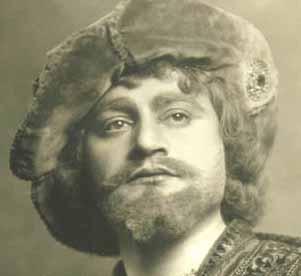Key Word Search
Multi-Field Search
Browse
Repertory Report
Performers Report
Contacts
Met Opera Website
New Production
Mefistofele
Metropolitan Opera House, Fri, November 26, 1920
Debut : Beniamino Gigli
Mefistofele (23)
Arrigo Boito | Arrigo Boito
- Mefistofele
- Adamo Didur
- Faust
- Beniamino Gigli [Debut]
- Margherita
- Frances Alda
- Elena
- Florence Easton
- Wagner
- Angelo Badà
- Marta
- Kathleen Howard
- Pantalis
- Flora Perini
- Nerèo
- Giordano Paltrinieri
- Conductor
- Roberto Moranzoni
- Director
- Samuel Thewman
- Designer
- Boris Anisfeld
- Choreographer
- Rosina Galli
Mefistofele received nine performances this season.
Review 1:
Review of Richard Aldrich in The New York Times
OPERA 'MEFISTOFELE' BY BOITO REVIVED
Metropolitan Again Gives Work from Goethe's 'Faust" After Thirteen Years
Beniamino Gigli Makes Debut as Faust - Didur in Title Role and Mme. Alda as Marguerita.
The book has less of sequence than Berlioz's "Damnation of Faust." It is an assemblage of scenes; there is no "story" in it; there is no opportunity or possibility for continuous dramatic development or for more than disconnected effects. To make sure of capturing something of Goethe's spirit of mystic symbolism, Boito goes to the second part of "Faust" for the last scenes of his drama, the "Night of the Classical Sabbath" with the wooing of Elena by Faust (who has just left Margherita's death bed in the prison), and the epilogue, the death of Faust in his study as an old man, assured of salvation by hosts of angels, and the routing of Mephistopheles by the same phalanx.
There is not much to be found in Boito's opera but the stirring of an impressionable pictorial imagination by contact with Goethe's vast canvas. The music is a strange compound of portentous sonorities and characteristically Italian melody. There is, it must be confessed, a certain dilettante quality in some of it; there are many bare places, many empty passages; but there are passages of power, passion and imagination. The plan of the prologue is impressive: the vast enveloping clouds; the hymning of the invisible mystic choir; the sonorous proclamation of the pompous motto-theme by the brass instruments; the sudden appearance of Mephistopheles ironically denying. But it is carried out at a length that becomes tedious. From the rest there emerge the garden scene with a charm of its own in sweet melodiousness, a delicate development of the ensemble, rather unconvincing music in the Kermesse, a glowering brilliance in Mephistopheles' "Ballad of the World," in the Witches' Sabbath, an otherwise not very terrifying chorus of hags, but elaborated with all the resources of mingling throngs and vivid colors, Margherita's air in the prison, an example of how the florid style may be made to say something dramatic, and, more than all else, the duet between her and Faust in the same scene, "Lontano, lantano," of ethereal and exquisite beauty. There are, too, traits of tranquil charm in the scene of the classical Sabbath.
Mr. Mardones was to sing the rôle of Mefistofele, but illness compelled him to hand the part over to Mr. Didur. It may well be imagined that he put all there is of sardonic diabolism in vocal color - his voice was unsteady in the upper ranges - in facial expression, pose and gesture into his impersonation. Mme. Alda's Margherita somewhat mature in aspect, less beautiful to listen to. Some of her auditors had memories that went back to the extraordinary impersonation of Mme Calvé or, even farther, to Mme. Nilsson, which were not effaced.
It has been usual for the singer to take the part of Elena in the fourth act who has just represented the death of Margherita at the end of the third. Whatever the symbolism, if any, may be, a sense of the fitness of things is more gratified by the appearance of a different singer, who was in this case Mme. Easton. It may be said likewise that the sense of hearing was much more fully gratified.
As Faust another new tenor of the company made his first appearance, Beniamino Gigli. Here's an Italian tenor, by no means a beginner, but with many of the inclinations and manners of his kind, such as a persistent disposition to sing to the audience, to the neglect of Margherita or whomever else a dramatic situation requires him to address. Also to cultivate the high note and make whatever there is to be made out of it in the way of applause. But he has a voice of really fine quality, which he does not often force, still fresh and possessed of color. And he sings not without finish and style. He is evidently at home in the part and indicated assurance and experience on the stage, though his notion rarely rose above the safely conventional. He will no doubt be another valuable accession to the company. There was, of course, new scenery for this production and, as it was painted by Mr. Boris Anisfeld, it was strongly touched with post-impressionism.
Mishkin Photograph of Beniamino Gigli in Mefistofele
Search by season: 1920-21
Search by title: Mefistofele,
Met careers
- Roberto Moranzoni [Conductor]
- Adamo Didur [Mefistofele]
- Beniamino Gigli [Faust]
- Frances Alda [Margherita]
- Florence Easton [Elena]
- Angelo Badà [Wagner]
- Kathleen Howard [Marta]
- Flora Perini [Pantalis]
- Giordano Paltrinieri [Nerèo]
- Samuel Thewman [Director]
- Boris Anisfeld [Designer]
- Rosina Galli [Choreographer]
